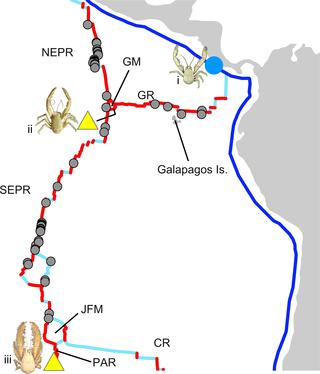PLOS ONE ( IF 3.7 ) Pub Date : 2018-03-16 , DOI: 10.1371/journal.pone.0194696 Christopher Nicolai Roterman , Won-Kyung Lee , Xinming Liu , Rongcheng Lin , Xinzheng Li , Yong-Jin Won

|
The recent discovery of two new species of kiwaid squat lobsters on hydrothermal vents in the Pacific Ocean and in the Pacific sector of the Southern Ocean has prompted a re-analysis of Kiwaid biogeographical history. Using a larger alignment with more fossil calibrated nodes than previously, we consider the precise relationship between Kiwaidae, Chirostylidae and Eumunididae within Chirostyloidea (Decapoda: Anomura) to be still unresolved at present. Additionally, the placement of both new species within a new “Bristly” clade along with the seep-associated Kiwa puravida is most parsimoniously interpreted as supporting a vent origin for the family, rather than a seep-to-vent progression. Fossil-calibrated divergence analysis indicates an origin for the clade around the Eocene-Oligocene boundary in the eastern Pacific ~33–38 Ma, coincident with a lowering of bottom temperatures and increased ventilation in the Pacific deep sea. Likewise, the mid-Miocene (~10–16 Ma) rapid radiation of the new Bristly clade also coincides with a similar cooling event in the tropical East Pacific. The distribution, diversity, tree topology and divergence timing of Kiwaidae in the East Pacific is most consistent with a pattern of extinctions, recolonisations and radiations along fast-spreading ridges in this region and may have been punctuated by large-scale fluctuations in deep-water ventilation and temperature during the Cenozoic; further affecting the viability of Kiwaidae populations along portions of mid-ocean ridge.
中文翻译:

一种新的雪人蟹系统发生学:发源于东太平洋的区域灭绝迹象
最近在太平洋和南大洋太平洋海域的热液喷口发现了两种新的猕猴桃深蹲龙虾,这促使人们重新分析了猕猴桃的生物地理历史。与以前相比,使用更大的比对和更多的化石校准结点,我们认为奇异科(十足目:Anomura)中的菊科,手足科和Eu科之间的精确关系目前仍未解决。此外,将两个新物种连同与渗出相关的Kiwa puravida一起放置在新的“ Bristly ”进化枝中最简单地解释为支持家庭发泄,而不是从头到尾的发展。化石校准的散度分析表明,东太平洋〜33-38 Ma始新世-渐新世边界周围的枝条起源,与太平洋深海底部温度降低和通风增加相吻合。同样,中新世中期(〜10-16 Ma)快速辐射到新的贝里斯提进化枝还与热带东太平洋的类似降温事件相吻合。东太平洋猕猴科的分布,多样性,树形拓扑结构和发散时间与该区域快速扩散的山脊上的灭绝,再定殖和辐射模式最一致,并且可能已因深水的大规模波动而被打断。新生代的通风和温度;进一步影响了洋中脊沿岸的猕猴科种群的生存能力。


























 京公网安备 11010802027423号
京公网安备 11010802027423号